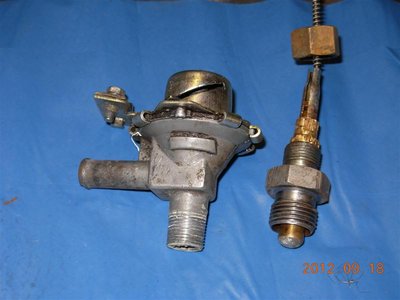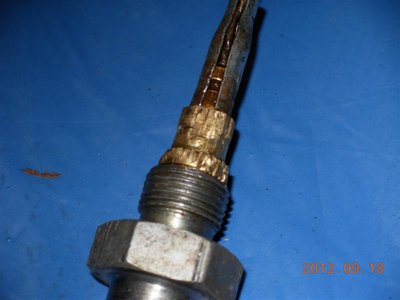Re: Getting OGU roadworthy again
Ah, now I recall the cause of my problem, but not exactly how to cure it.
Some long time ago, the junction of the heater's water valve and the head, corroded the original head and one of those firms, that over the years, I have employed for engine work, resolved the problem by boring the hole in the head bigger and cutting a bigger thread (a parallel one). To match this he/they made a non standard bulb adaptor out of steel. Clearly they made it a very tight fit on the bulb and either glued it in or the two-metal junction has 'welded' the bulb to the steel. They interchanged the positions of the water valve and temp sensor.
I presume that the standard adaptor has the same tapered thread as the water valve. Can someone confirm this?
Here is a photo of a water valve next to my non-standard bulb adaptor.
Attempts to separate the bulb from the adaptor using extreme torque, as mentioned above, have failed and have damaged the flats and the brass collar.
Rohan's suggestion of cutting the adaptor may be the only solution, but as you can see from the photo this is a tougher task than cutting the standard adaptor. This is hefty steel, not an aluminium alloy and it will be difficult to avoid sawing into the bulb.
Can someone tell me a source and/or the part number of the standard adaptor for the temperature bulb as clearly I will need to buy one to mate into my new head? The part does not seem to appear in any of the pictures here: http://www.rdent.com/manuals/index.html
Also does anyone know a good repair/renovation firm for this temperature instrument?
Some long time ago, the junction of the heater's water valve and the head, corroded the original head and one of those firms, that over the years, I have employed for engine work, resolved the problem by boring the hole in the head bigger and cutting a bigger thread (a parallel one). To match this he/they made a non standard bulb adaptor out of steel. Clearly they made it a very tight fit on the bulb and either glued it in or the two-metal junction has 'welded' the bulb to the steel. They interchanged the positions of the water valve and temp sensor.
I presume that the standard adaptor has the same tapered thread as the water valve. Can someone confirm this?
Here is a photo of a water valve next to my non-standard bulb adaptor.
Attempts to separate the bulb from the adaptor using extreme torque, as mentioned above, have failed and have damaged the flats and the brass collar.
Rohan's suggestion of cutting the adaptor may be the only solution, but as you can see from the photo this is a tougher task than cutting the standard adaptor. This is hefty steel, not an aluminium alloy and it will be difficult to avoid sawing into the bulb.
Can someone tell me a source and/or the part number of the standard adaptor for the temperature bulb as clearly I will need to buy one to mate into my new head? The part does not seem to appear in any of the pictures here: http://www.rdent.com/manuals/index.html
Also does anyone know a good repair/renovation firm for this temperature instrument?


